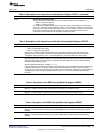
Architecture
www.ti.com
2.5.2 Programmable Asynchronous Parameters
The EMIF allows a high degree of programmability for shaping asynchronous accesses. The
programmable parameters are:
• Setup: The time between the beginning of a memory cycle (address valid) and the activation of the
output enable or write enable strobe
• Strobe: The time between the activation and deactivation of output enable or write enable strobe.
• Hold: The time between the deactivation of output enable or write enable strobe and the end of the
cycle, which may be indicated by an address change or the deactivation of the EM_CS signal.
Separate parameters are provided for read and write cycles. Each parameter is programmed in terms of
EMIF clock cycles.
2.5.3 Configuring the EMIF for Asynchronous Accesses
The operation of the EMIF's asynchronous interface can be configured by programming the appropriate
memory-mapped registers. The reset value and bit position for each register field can be found in
Section 4. The following tables list the programmable register fields and describe the purpose of each
field. These registers should not be programmed while an asynchronous access is in progress. The
transfer following a write to these registers will use the new configuration.
Table 3 describes the asynchronous configuration register (ACFGn). There are four ACFGns. Each chip
select space has a dedicated ACFGn. This allows each chip select space to be programmed
independently to interface to different asynchronous memory types.
Table 3. Description of the Asynchronous Configuration Register (ACFGn)
Parameter Description
SS Select Strobe mode. This bit selects the EMIF's mode of operation in the following way:
• SS = 0 selects Normal mode. EM_CS is active for duration of access.
• SS = 1 selects Select Strobe mode. EM_CS acts as a strobe.
EW Extended Wait mode enable.
• EW = 0 disables Extended Wait mode
• EW = 1 enables Extended Wait mode
When set to 1, the EMIF enables its Extended Wait mode in which the strobe width of an access
cycle can be extended in response to the assertion of the EM_WAIT[5:2] pins. The WPn bit in the
asynchronous wait cycle configuration register (AWCCR) controls the polarity of the EM_WAITn pin.
See Section 2.5.8 for more details on this mode of operation.
W_SETUP/R_SETUP Read/Write setup widths.
These fields define the number of EMIF clock cycles of setup time for the address pins (EM_A and
EM_BA) and asynchronous chip enable (EM_CS) before the read strobe pin (READ_OE) or write
strobe pin (WRITE_WE) falls, minus 1 cycle. For writes, the W_SETUP field also defines the setup
time for the data pins (EM_D). Refer to the datasheet of the external asynchronous device to
determine the appropriate setting for this field.
W_STROBE/R_STROBE Read/Write strobe widths.
These fields define the number of EMIF clock cycles between the falling and rising of the read strobe
pin (READ_OE) or write strobe pin (WRITE_WE), minus 1 cycle. If Extended Wait mode is enabled
by setting the EW bit in the asynchronous configuration register (ACFGn), these fields must be set to
a value greater than zero. Refer to the datasheet of the external asynchronous device to determine
the appropriate setting for this field.
W_HOLD/R_HOLD Read/Write hold widths.
These fields define the number of EMIF clock cycles of hold time for the address pins (EM_A and
EM_BA) and asynchronous chip enable (EM_CS) after the read strobe pin (READ_OE) or write
strobe pin (WRITE_WE) rises, minus 1 cycle. For writes, the W_HOLD field also defines the hold
time for the data pins (EM_D). Refer to the datasheet of the external asynchronous device to
determine the appropriate setting for this field.
TA Minimum turnaround time.
This field defines the minimum number of EMIF clock cycles between the end of one asynchronous
access and the start of another, minus 1 cycle. This delay is not incurred when a read is followed by
a read, or a write is followed by a write to the same chip select space. The purpose of this feature is
to avoid contention on the bus. Refer to the datasheet of the external asynchronous device to
determine the appropriate setting for this field.
12
Asynchronous External Memory Interface (EMIF) SPRUEQ7C–February 2010
Submit Documentation Feedback
Copyright © 2010, Texas Instruments Incorporated


















